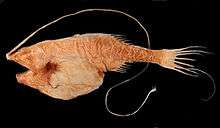Whipnose angler
The whipnose anglers are a family, Gigantactinidae, of deep-sea anglerfishes. The family name is derived from the Greek words gigas, meaning "big", and aktis, meaning "ray". They are distinguished by the presence of a remarkably long lure (the illicium), which may be longer than the body of the fish.[1][2]
| Whipnose anglers | |
|---|---|
 | |
| Scientific classification | |
| Kingdom: | |
| Phylum: | |
| Class: | |
| Order: | |
| Family: | Gigantactinidae |
| Genera | |
Description
Whipnose angler females are easily recognizable because they have an elongated shape and a small head. Their illicium length is an average of one to four times the size of their standard length. The family includes 22 species in two genera. Like the other ceratioid groups, little is known about their ecology, but this species lives a benthic lifestyle while possibly swimming upside down while it is foraging. They tend to drift motionless to lure in their prey.[3]
Location
Whipnose anglers can be found in all three major oceans. The northernmost location of the females has been recorded near southern Greenland, while the southernmost location was recorded at 50°S in the Atlantic sector of the Southern Ocean. The species may possibly be one of the deepest-living ceratoids at maximum depths exceeding 1000 m.[3]
References
- Froese, Rainer, and Daniel Pauly, eds. (2008). "Gigantactinidae" in FishBase. September 2008 version.
- Bertelsen, E.; Pietsch, Theodore W. (2002). "New Species of Deep-Sea Anglerfish of the Genus Gigantactis (Lophiiformes: Gigantactinidae) from the Western North Atlantic Ocean". Copeia. American Society of Ichthyologists and Herpetologists. 2002 (4): 958–961. doi:10.1643/0045-8511(2002)002[0958:nsodsa]2.0.co;2. JSTOR 1448514.
- "Gigantactinidae Details Whipnose Anglers". Encyclopedia of Life. Retrieved 23 December 2012.